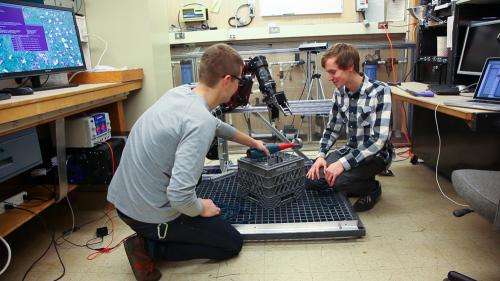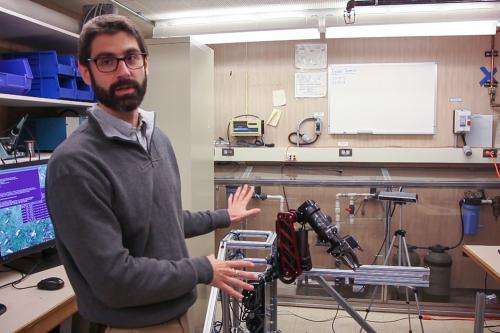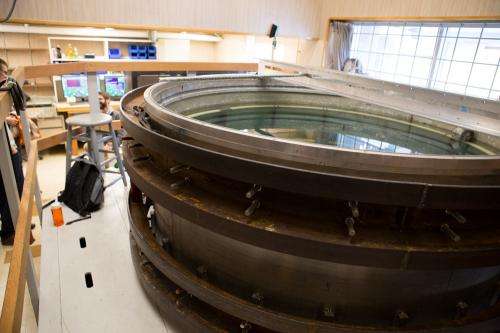Startup creates underwater robotics with a human touch

It should be just as easy to use a robotic arm as it is to use your own hand. That's the thinking behind University of Washington startup BluHaptics, which is taking telerobotics—controlling robots from a distance—to a new level: underwater.
Using technology developed by Dr. Howard Chizeck's lab in the UW Department of Electrical Engineering, a team of UW scientists and engineers working at the Applied Physics Laboratory (APL) is creating a control system for underwater Remotely Operated Vehicles (ROVs). ROVs can perform a variety of undersea tasks too dangerous – or even impossible – for humans, ranging from oil and gas exploration, biohazard clean-up and mining, to environmentally sensitive scientific research.
The UW research team is working with a "submersible manipulator test bed" at APL, which is comprised of specialized, submersible equipment similar to what's used in the oil & gas industry for offshore operations. This equipment is submerged in a large water tank for a realistic test environment.
"Essentially, we're combining the spatial awareness of a computer system with the perceptive capability of a human operator," explained Andy Stewart, a senior engineer in the Ocean Engineering department and part of the BluHaptics team. "To do this, we use what's called a haptic device."
Haptics describes feedback technology that takes advantage of the sense of touch by applying forces, vibrations or motions to the user. The haptic device is used to both control the robot and to provide force feedback to the user. This feedback guides the human operator to the desired location, pushing back on the hand to avoid collisions or other mistakes. The haptic input device is similar to using a mouse with a computer, Stewart explained, "but it's giving three-dimensional input, so you're actually defining a point in space where you want the robotic arm to go."
"Haptics does for the sense of touch what computer graphics do for vision," explained Chizeck, who co-directs the UW Bio-Robotics Lab and is the Principal Investigator of this effort. "APL brought us expertise in underwater operations, underwater sensors and underwater robotics that we could combine with our haptic technology."
The technology creates a virtual representation based on a combination of sonar, video and laser inputs – sensory feedback that enhances the human-robotic interface and speeds up operations. This translates into tackling the task at hand safely and more efficiently, while greatly reducing the risk of damage to the environment.
The BluHaptics robotic control system is based on key algorithms developed by Dr. Fredrik Ryden in the UW Department of Electrical Engineering, as part of his PhD. This work was originally directed to robotic surgery, which allows surgeons to operate remotely via a computer connected to a robot – a surgical alternative for certain medical procedures that can mean enhanced precision and less trauma for the patient, and decreased fatigue for the surgeon. BluHaptics is now applying and modifying these same algorithms to underwater robotics.
C4C provided the team with $50k of Commercialization Gap Funding to move the technology from the lab to a commercial product. This funding also has been used to employ UW entrepreneurial undergraduates to work on the project.
C4C has also granted Ryden a Commercialization Post-Doctoral Fellowship that gives him a year to work on the technology, explore the business issues and figure out what the ideal product should be.

"The coolest thing about this project is that we're taking technology developed in a University of Washington lab and we're actually commercializing it," Ryden said. "And there are multiple areas of research involved – computer vision, sensor fusion, control theory and ocean engineering – that allow us to be able to package this in a robust system that can operate at deep ocean depths."
"BluHaptics chose the underwater market to be our first commercialization opportunity because there are over a thousand ROVs operating today in the oil and gas industry," explained Mark Lunde, a veteran industry expert and mentor who C4C helped introduce to the team to guide them through the commercialization process. "And that number has grown 27 % in the past five years. Additionally, there is $1.7 billion a year being invested in this industry." Lunde now serves as President of BluHaptics.
"By bringing the human sense of touch back from the robot to the hand, BluHaptics is making it easier, safer and more reliable to use remote robots," Chizeck said. And while the company's current focus is on guiding precision operations deep undersea, this remote telerobotics technology holds promise for a number of future potential markets as well.

"This has implications for search and rescue, infrastructure inspection, remote maintenance, homeland security and anti-pollution activities," Chizeck said.
Provided by University of Washington




















